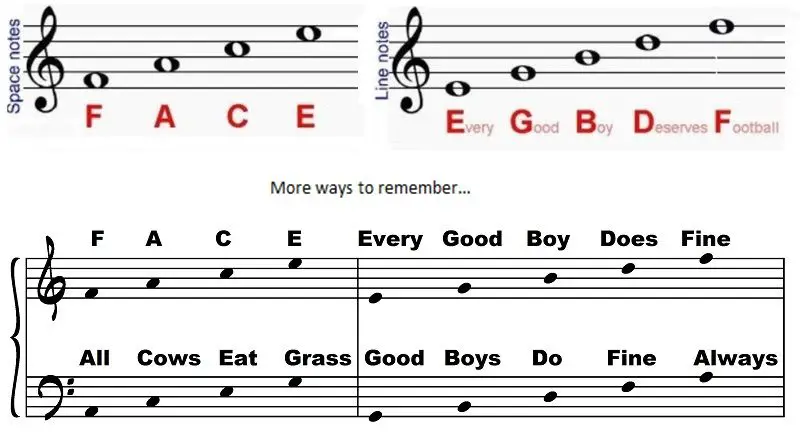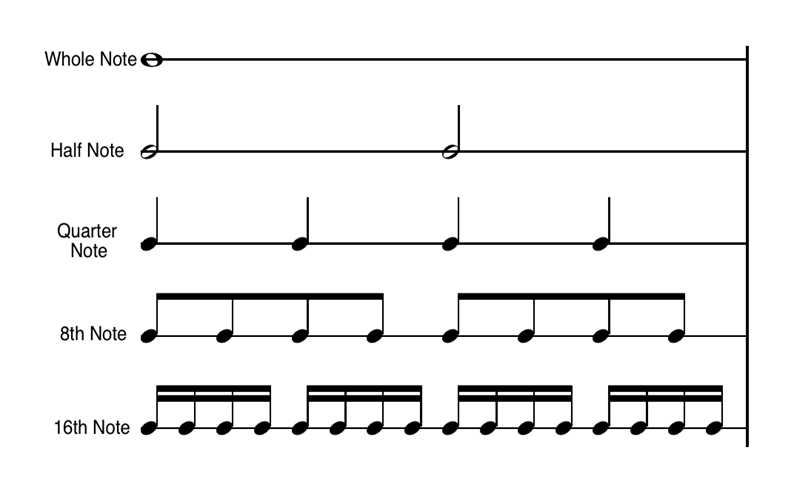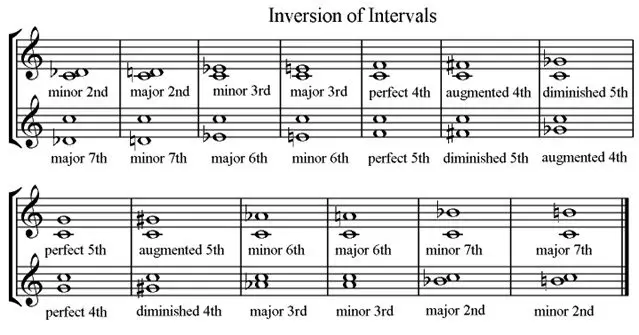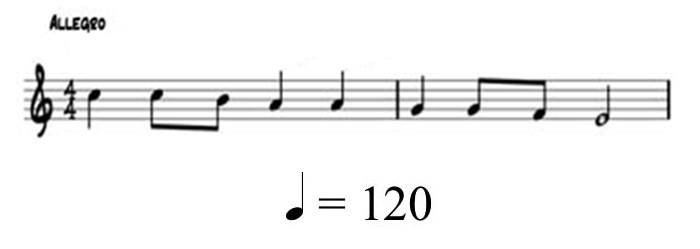
Music theory involves learning about rhythm, melody, harmony, dynamics, etc., which are the key ingredients that make a complete piece of music. The music theory lessons here will give you a good start in music theory.
What is Music Theory?
In Music Theory, the aim is to study the way music is read and written. The way music is interpreted forms a major part of this study.
It involves knowing the various elements that go in the creation of music, be it rhythm, melody, harmony, dynamics, musical forms, etc.
It means knowing what notes work together and sounds pleasing together, as well as knowing the notes that create tension and dissonance when played together. You also learn how to go about giving a structure or form to a song.
- Music theory helps you play and understand music better
- Develop Professional Vocabulary and communicate better
- Provides you more ideas to create (by using chord progressions, finger exercises, riffs).
Here, you will find a lot of information on music theory, which will take you from the beginning to the more advanced concepts.
Musical Notes and Pitches
Sound is nothing but vibrations produced in air. The frequency of the vibration is known as a Pitch (for example 440 Hz). The greater the frequency, the higher sounding the pitch!
The various pitches are then named as musical notes. It is these musical notes that we need to know and recognize to be able to play any musical instrument.
The seven musical notes are: A B C D E F G.
Besides these seven notes, there are accidentals which sharpen or flatten these seven basic notes.

You can read more about musical notes here.
So, a pitch is basically a particular frequency of sound, and note is a name for that pitch.
Here are some more ways in which the seven musical notes are referred.
In the Solfege system, the seven musical notes are called – do, re, mi, fa, sol, la, and ti (total seven syllables for the seven notes).
In Indian style, the seven musical notes are named as sa, re, ga, ma, pa, dha, ni
Also Read: Why piano is so important to music studies
Accidentals in Music Theory
https://www.keytarhq.com/accidentals-in-music/Accidentals are musical symbols that are used to change the pitch of a note.
The pitch can either be raised or lowered and the change can be either a half step or a whole step. We know that all the seven notes, denoted by alphabets, are basically white keys.
The black keys on a piano are named by placing the accidentals next to the name of these notes.
The Various Accidentals
Let us go through the various symbols denoting the different music accidentals.
Sharp: The ‘sharp’ raises a note by a half step (semitone) and it is denoted by placing ‘#’ next to the note. For example G# is the black note immediately to the right of G.
Flat: The ‘flat’ lowers a note by a half step (semitone) and it is denoted by placing ‘b’ next to the note. For example Bb is the black note immediately to the left of B.
Double Sharp: While a sharp raises a note by a half step, the “double sharp” raises a note by a whole step (2 semitones). It is denoted by placing an ‘x’ next to the note. For example Cx is same as the D note since it is one whole step above C.
Double Flat: While a flat lowers a note by a half step, the “double flat” lowers a note by a whole step (2 semitones). It is denoted by placing ‘bb’ next to the note. For example Dbb is same as the C note since it is one whole step below D.
Natural: This sign cancels out any of the previous accidentals and the note needs to be played assuming no accidental i.e. you need to play the white key.
Grand Staff, Ledger Lines, Treble & Bass Clef Notes
Pick up any piece of written music and you can see groups of lines on which music note symbols are written. In standard Western musical notation, this group of lines (on which the music notes are drawn) is known as the Staff (and ledger lines).
Read more on Grand Staff, Ledger Lines, Treble & Bass Clef Notes
Look ahead
When sight-reading, you should constantly look ahead and aim for continuity while playing, this is the secret of reading music. This is a habit that you will need to develop else you will have to constantly pause till you eyes fall on the next set of notes.
Note Duration: Whole Note, Crotchet, Quaver
To be able to read music and to play any song correctly, you should be able to recognize the duration for which the various notes need to be played.
In music, notes can be of various types (depending on Note Duration): Whole note, half-note, crotchet, quaver, semi-quaver.
These notes share a relationship among themselves with respect to Time, which is as follows.
- Two Half notes equals one Whole note
- Four Quarter notes equals one Whole note. Put in another way, the Quarter note is one-fourth or a quarter of a Whole note
- Two Quarter notes equals one Half note
- Two Eighth note equals one Quarter note
- Two Sixteenth note equals one Eighth note
For any song to sound good, you have to play the notes for the right number of beats and also pick them up on the correct beats.
It is not at all difficult to learn this concept since the duration depends on the type of the Note/Rest and each type has a fixed length. Besides, there is also a relationship among the various Notes as depicted in the chart below.

Whole Note (also Known As Breve)
This note lasts for 4 beats. Assuming the time signature is 4/4, a whole note will last for one complete bar. It is the equivalent of 4-quarter notes. So if you like to tap your foot while playing, remember to tap your foot for 4 consecutive beats while this note is pressed.
You won’t find this note in a 3/4 or waltz time. This is because in 3/4 time, every bar can contain notes equivalent to only 3-quarter notes, which is one short of what a Breve needs.
Half Note: How to Play
Half Note is also Known As Semi-Breve and it lasts for 2 beats. This musical note is called a Half note because it is half of a Whole note in terms of time duration.
So assuming the time signature is 4/4, a Semi-Breve will last for 2 beats of the bar. So in a bar, you can have a maximum of two Half Notes, provided the meter is 4/4.
Whenever you encounter this note while playing, remember to tap your foot for 2 consecutive beats while this note is pressed.
Crotchet – A Quarter Note
A Crotchet is also known as a Quarter Note. It has time duration of a quarter of a whole note. So one Whole note equals four Crotchets. It is half in time when compared to a Half-Note.
A Crotchet lasts for one beat (you just need to tap your feet once). So assuming the time signature is 4/4, you can have four Quarter Notes in a bar, since every quarter note lasts for one beat. A 3/4 meter on the other hand can have 3 Quarter Notes in a bar.
Quaver – Eighth Notes
A Quaver is also known as an Eighth Note. This musical note has time duration of an eighth of a whole note. It is half in time when compared to a Crotchet / Quarter note. Also notice that this note has one stem.
You can fit two Quavers in one beat. So assuming the time signature is 4/4, you can have eighth such notes in a bar. A 3/4 meter on the other hand can have 6 Eight Notes in a bar.
In this case, while tapping your foot to count the beats, you need to count as 1-and, 2-and, 3-and, 4-and and play the eighth notes on either the number or the and.
Semi Quaver – Sixteenth Notes
Semi Quaver is a musical note which has a time duration of a sixteenth of a whole note. For that reason, a semiquaver is also known as a sixteenth note. It is half in time when compared to an eight note. Notice the two stems for this note.
You can fit four semiquavers in one quarter beat. So assuming the time signature is 4/4, you can have sixteen such notes in a bar. A 3/4 meter on the other hand can have twelve sixteenth notes in a bar.
Timing sixteenth notes takes practice and for that reason you will not find these notes in the beginner lessons. Since you can have four semi-quaver notes on every beat, while tapping your foot to count the beats, you need to count as 1-and-a-and, 2-and-a-and, 3-and-a-and, 4-and-a-and. Notice the four placeholders in every beat where you can fit in the ‘Semi Quaver’ (sixteenth notes).
Rests – Play Nothing
Rests is music actually means silence. There are different types of rests, they have duration but no pitch.

If you carefully listen to any song, you will observe that not all the instruments, including the melody, play together for the entire duration of the song. There will be times when certain instruments or the melody itself will stop for some time and then it will start again at some other point.
The duration for which there needs to be silence is identified by Rests.
There are various types of Rests and they are similar to the various types of Notes. Meaning, for every type of Note, you will find a corresponding Rest type and they will be equal in duration. For instance, a Quarter Rest will occupy the same time as a Quarter Note, the difference being the Note would make a sound whereas the Rest would be silent.
Music Intervals
Musical interval is the distance between two musical notes in semitones (on the piano distance between any two keys is one semitone, on guitar each fret represents one semitone).

Here are the various music interval types.
- >Unison – 1, Second – 2nd, Third – 3rd, Fourth – 4th, Fifth – 5th, Sixth – 6th, Seventh – 7th
- Octave – 8ve, Ninth – 9th, Tenth – 10th, Eleventh – 11th, Twelfth – 12th, Thirteenth – 13th
These can further be classified as Major (M), Minor (m), Perfect (P), Augmented (A), and Diminished (d). The letters in the brackets are symbols which can also be used to identify them.
You will also hear terms such as semi-tones and whole-tones which are nothing but Minor-Second and Major-Second intervals.
If we use the note C as the root note (of the scale or chord we’re working with), here are the various intervals that can be formed (symbols of the intervals are in parenthesis):
- C: the tonic, the root (T or R);
- Db, a semitone above the root: the minor second (b2 or m2);
- D, a whole-tone above the root: the major second (M2);
- D#, a whole-tone plus a semitone above the root: the augmented second (#2 or aug2);
- Eb, the same note as D# but with a different name (we’ll discuss this later): the minor third (b3 or m3);
- E, two whole-tones above the root: the major third (M3);
- F, two whole-tones plus a semitone above the root: the perfect fourth (P4);
- F#, three whole-tones above the root: the augmented fourth (#4 or aug4);
- Gb, the same note as F#: diminished fifth (b5 or dim5);
- G, three whole-tones plus a semitone above the root: perfect fifth (P5);
- G#, four whole-tones above the root: augmented fifth (#5 or aug5);
- Ab, the same note as G#: minor sixth (b6 or m6);
- A, four whole-tones plus a semitone above the root: major sixth (M6);
- Bbb (this note is one whole-tone below B because it has two flats!), the same note as A: diminished seventh (bb7 or dim7);
- Bb, five whole-tones above the root: minor seventh (b7 or m7);
- B, five whole-tones plus a semitone above the root: major seventh (M7).
After that, the seconds are called ninths, the fourths are called elevenths and the sixths are called thirteenths.
An interval can also be called Harmonic or Melodic depending on the way it is played.
- Harmonic – When you play the two notes simultaneously
- Melodic – When you play the two notes one after the other
Importance of Keys
If played on any musical instrument, a song in one particular scale may sound similar to what it may sound on another scale but when you hear the complete arrangement with all the tracks of the song, you will find that the song sounds better in certain scales.
Read more on Scales & Key Signatures
The composer may even decide to use key change, also known as modulation (moving from one key to another), within the piece to add more variety and prevent monotony within the piece.
Most modulation happens to closely related keys (usually with no more than one sharp or flat difference in the Key Signature).
Time Signatures in Music
Time Signature indicates the number of beats in every measure/bar of music. Measure/Bar are series of sections that you get when the vertical black lines called bar lines divide the staff. Learn more about time signatures (the different meters) in music, learn how to keep beat and maintain rhythm while playing music.
A time signature is also known as meter and it is the composer of the music who decides what should be the meter of the song.
There are several time-signatures on which a song could be based, the most common being the 3/4 and the 4/4 meter. The meter is mentioned at the beginning of the first bar!
A beat is the method by which you count out music (i.e. 1, 2, 3, 4…).
In time signature, the bottom number tells you the kind of beat. The top number tells how many beats in one measure of music.
For example, if the time signature is 3/4, you would count the measure as: 1, 2, 3. and repeat. If it is 2/4, you will count 1, 2. and repeat.
If the bottom number is 4, it means each beat is a quarter note. If the bottom number is 8, that means each beat is eighth note. If the bottom number is 16, it means it is sixteenth note.
Common Time
This is the most common meter in music. It is also known as 4/4 meter. This time signature indicates that every bar has four quarter note beats.
Waltz Time
Another common meter is the 3/4 meter, which is also known as Waltz time. This meter has three quarter note beats in every bar.
March Time
This is the 2/4 meter, which is also known as March time. This meter has two quarter note beats in every bar.
Other Time Signatures
The above mentioned time signatures are the most common and you will find almost all the songs based on them. But there are some other time signatures as well, basically the non-quarter note time signatures.
6/8 time – It has six eighth notes in a bar
3/2 time – has three half notes in a bar
BPM (Beats per minute) & Tempo
Every song has its own speed, which in music theory, is denoted by the Tempo of the song, also known as BPM (beats per minute). The Tempo is the speed at which the piece of music has to be played. If you observe a sheet music, you will find the tempo mentioned at the beginning of notation.
Tempo could be specified in different ways:
- Exact: In this case, a number is mentioned. You can see a number written next to a small music note (♩ = 70).
- It means you have to maintain a speed of 70 beats per minute. Tempo is also expressed in word form (mostly Italian words)

Here’s a list of the commonly used Italian tempo commands that you will find in written music (piano or other musical instruments).
- Largo is 40-60 BPM
- Larghetto is 60-66 BPM
- Adagio is 66-76 BPM
- Andante is 76-108 BPM
- Moderato is 108-120 BPM
- Allegro is 120-168 BPM
- Presto is 168-200 BPM
- Prestissimo is 200+ BPM
The best way to play a piece of music at the right tempo is to practice using a metronome. Musical instruments like electronic keyboards / digital pianos have built-in metronome. However, for most acoustic instruments, you need to buy a metronome separately in order to practice at the correct tempo.
What is Melody in Music?
Melody is the tune of any song or piece, the part that we usually hum of our favorite songs. It is a series of notes that is played in succession.
If you listen to your favorite song, the part that the singer sings is usually the melody. It’s the melody of a song that you usually remember and like to hum. It’s also often referred to as the tune of a song.
Every song has a melody and the accompaniment or the accompanying harmonic notes (often called the arrangement).
So if you see the sheet music of “Twinkle Twinkle Little Star” below, the notes in the treble clef is basically the melody of the song.

To create a piece, a composer would normally start using some melody notes and then build upon it or take some chord progression and then build upon it. To create a musical piece/melody, the composer would use elements like: the musical notes, their duration, dynamics, and selection of various musical instruments.
How to Learn Songs Quickly
Here’s how to learn difficult / tough music pieces quickly. These tips applies to any musical instrument.
A simple trick to learn seemingly difficult songs is to break the song into multiple sections before you attempt to learn it.
Most beginners usually start on a new song and try to play the song right from the first bar to the last bar, all at one stretch.
The result is you get frustrated.
So it is important to practice in small steps, or sections, a few bars at a time and then link them up.
So you would go from the first section to the next section and so on, till you can play the entire song together on the piano.
Though you may have started off playing the sections at a slower tempo, once you have learnt how to play the various sections, it is important to play them at a faster tempo.
Related: Learn to play piano
Music Notation Software
Music notation is a system of notating music notes so that its easier to communicate with other musicians, and also easy to preserve music (back in those days when audio recording and playback was not popular).
For example, if you want to play any particular song or your favorite classical music, you will have to refer to it’s sheet-music (which will have the complete printed notations) to understand how the song is to be played.
The standard music notation is the most popular of notating music, but other formats (such as tabs) have also emerged.
MuseScore Review: Music Notation Software
MuseScore is a popular free music notation software that you can use for writing music (musical notation) on computer. In case you don’t have the budget yet to buy a Sibelius or a Finale, you can get MuseScore, a cost effective alternative to create sheet music.
MuseScore is used by musicians to compose music and to transcribe popular works, in order to make them freely available to musicians around the world. If you’re a music teacher, student or a musician, you should check out MuseScore. With MuseScore, you can print (and share) free sheet music for piano, guitar, flute on the world’s largest community of sheet music creators.
MuseScore is free and safe to download. You can find the latest version of MuseScore here. Just download the correct one (for your computer’s operating system), give it execute permission, and then run it
Leave a Reply